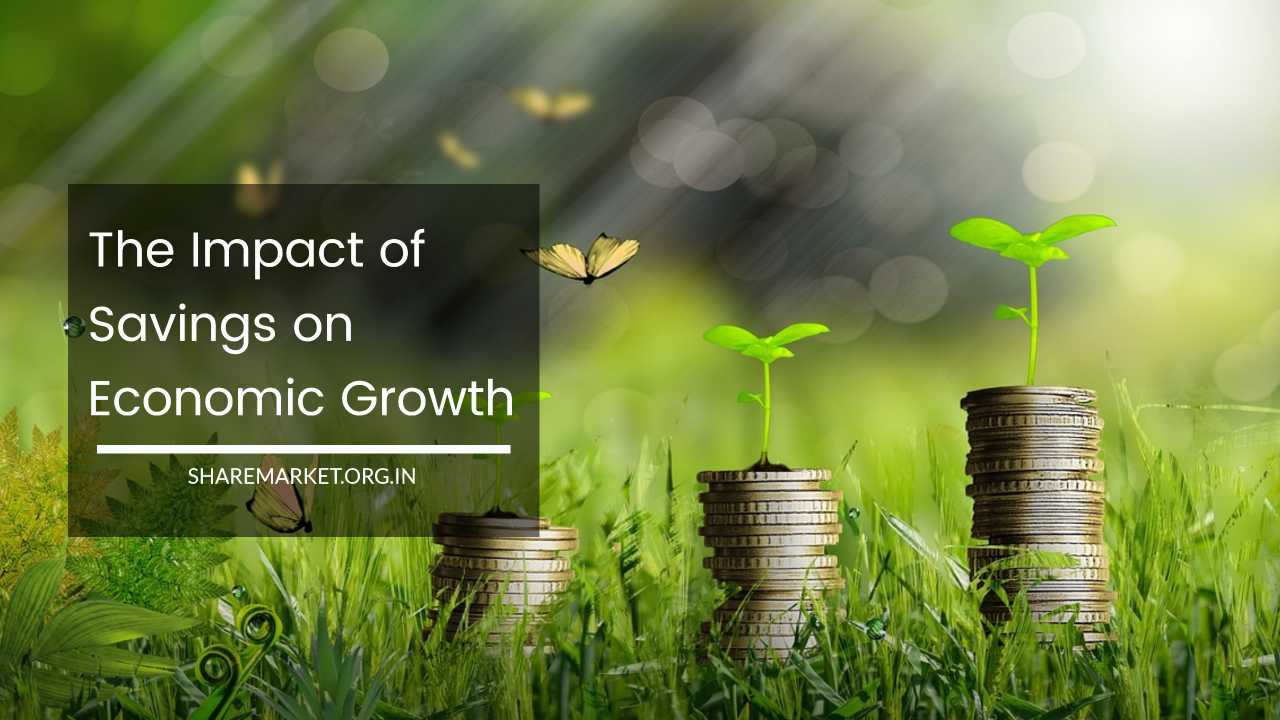The Impact of Savings on Economic Growth

The Impact of Savings on Economic Growth
The Impact of Savings on Economic Growth
Savings are often revered as a fundamental virtue in Indian households, reflecting a cultural and financial principle that underscores the importance of financial prudence and foresight. While this perspective is rooted in tradition, it plays a crucial role in shaping broader economic trends.
The intricate relationship between savings and economic growth reveals a complex interplay within the economic system, underscoring how savings contribute to the overall economic landscape.
This article delves into the multifaceted impact of savings on economic growth, explores the unique context of India, and examines the challenges and opportunities that lie ahead.
Understanding Savings: A Cornerstone of Economic Growth
Savings, defined as the portion of income not consumed but set aside for future use, serve as a fundamental driver of economic growth.
This seemingly simple concept is foundational to economic stability and expansion. When individuals, businesses, or governments save, they effectively create a pool of funds that can be directed towards productive investments.
These investments are crucial for creating new assets, technologies, and businesses, which, in turn, stimulate economic growth and development.
Key Components of Savings
Household Savings: This is the primary source of savings and is influenced by various factors, including income levels, cultural attitudes towards savings, and financial literacy.
Household savings are often used for future consumption, investments, or to establish a financial safety net. The ability and willingness to save can significantly affect an individual’s and, by extension, a nation’s economic stability.
Corporate Savings: This category includes retained earnings by businesses that are not distributed to shareholders but reinvested in activities such as expansion, research, and development. Corporate savings are vital for business growth and innovation.
Companies that reinvest their profits contribute to technological advancements and economic dynamism, which are crucial for long-term economic growth.
Government Savings: Government savings, or fiscal surpluses, can be allocated to fund public infrastructure projects, social programs, and other initiatives that support economic stability and growth.
A government with surplus funds can invest in critical areas like education, healthcare, and infrastructure, which can enhance overall economic productivity and well-being.
The Savings-Investment Nexus
The relationship between savings and investment is often explained through the Harrod-Domar growth model. This economic theory posits that economic growth is directly proportional to the savings rate, assuming a fixed capital-output ratio.
According to this model, higher savings lead to increased investment, which drives economic growth. However, this theoretical model does not account for the complexities of the real-world economy.
The Multiplier Effect
An increase in savings can trigger a multiplier effect on income and output. When savings are invested, they create additional income for individuals and businesses. This additional income can lead to further savings and investment, generating a chain reaction of economic activity.
For example, if a factory receives investment and expands its operations, it hires more workers, who then spend their wages on goods and services. This spending creates more income for others, leading to further economic activity.
This multiplier effect amplifies the impact of savings on economic growth, creating a dynamic and self-reinforcing cycle.
Savings and Economic Growth in India: A Unique Perspective
India offers a unique case study in understanding the relationship between savings and economic growth due to its distinct demographic, cultural, and economic characteristics. The country’s rising incomes, expanding middle class, and cultural emphasis on thrift have led to a notable increase in savings rates over recent decades.
Key Factors Influencing Indian Savings
Demographic Dividend: India’s large and youthful population plays a significant role in savings. Young individuals often save for future needs such as education, marriage, and retirement. This demographic trend provides a substantial base for long-term savings and investment.
The growing working-age population contributes to increased savings and investment potential, which can drive economic growth.
Financial Inclusion: Efforts to expand access to banking and financial products have been crucial in encouraging formal savings.
Government initiatives such as Jan Dhan Yojana aim to bring more people into the formal financial system, thereby increasing the overall savings rate. Financial inclusion not only improves savings rates but also enhances economic stability by integrating more individuals into the formal economy.
Government Policies: Various government policies, including tax incentives for savings, social security schemes, and infrastructure development initiatives, significantly influence savings behavior.
For example, tax-saving instruments like Public Provident Fund (PPF) and National Pension Scheme (NPS) encourage individuals to save more.
Government infrastructure projects, such as highways and railways, also create an environment conducive to economic growth and investment.
Cultural Factors: The traditional Indian value of saving for future uncertainties continues to shape savings patterns. Cultural attitudes towards financial security and the practice of saving a portion of income for emergencies or future expenses are deeply ingrained in Indian society.
This cultural emphasis on saving helps to stabilize the economy by providing a financial cushion during times of economic uncertainty.
Challenges and Opportunities
While savings have significantly contributed to India’s economic growth, several challenges need to be addressed to maximize their potential impact. These challenges must be tackled to ensure that savings translate into effective investments and sustainable growth.
Challenges
Low Financial Literacy: A significant portion of the Indian population lacks understanding of financial products and investment options. This lack of financial literacy can lead to suboptimal savings decisions and underutilization of available financial tools.
Financial literacy programs are essential to educate individuals about investment options, risk management, and effective saving strategies.
Informal Economy: A large segment of the Indian economy operates informally, which limits the tax base and reduces the potential for savings to be mobilized into formal investment channels.
The informal sector’s prevalence can undermine the efficiency and effectiveness of the savings-investment linkage. Addressing this challenge involves formalizing the informal economy and increasing its integration into the formal financial system.
Infrastructure Gaps: Insufficient infrastructure, including inadequate transportation, energy, and digital facilities, can hinder the efficient utilization of savings.
Effective infrastructure is crucial for facilitating investment and ensuring that savings are channeled into productive uses. Investing in infrastructure development is necessary to create an environment that supports economic activity and growth.
Income Inequality: High levels of income inequality can lead to uneven distribution of savings. This disparity can impact overall economic growth by concentrating resources in the hands of a few, reducing the potential for widespread economic benefits.
Addressing income inequality through progressive taxation and social welfare programs is essential for ensuring more equitable growth.
Opportunities
To harness the full potential of savings, India must focus on several key areas:
Promote Financial Literacy: Comprehensive educational programs to enhance financial literacy are crucial. By educating the population about various savings and investment options, individuals can make more informed decisions, leading to better utilization of their savings.
Financial literacy initiatives should include workshops, seminars, and online resources that cover topics such as budgeting, investing, and retirement planning.
Strengthen Financial Institutions: Developing a robust and inclusive financial sector is essential. This includes improving access to financial services, ensuring transparency, and fostering trust in financial institutions. Strengthening the financial sector can enhance the efficiency of savings mobilization and investment, leading to more robust economic growth.
Improve Infrastructure: Investing in infrastructure is crucial for facilitating investment. Improved transportation, energy, and digital infrastructure can enhance the efficiency of savings utilization and contribute to overall economic growth. Infrastructure development projects should focus on reducing bottlenecks, improving connectivity, and supporting technological advancements.
Encourage Entrepreneurship: Creating an environment conducive to startups and small businesses can stimulate innovation and economic activity.
Policies that support entrepreneurship, such as access to capital, mentorship programs, and regulatory support, can help channel savings into new ventures and drive job creation and economic growth.
Savings and Inclusive Growth
While savings are a critical driver of economic growth, their impact is maximized when accompanied by efforts to ensure inclusive growth.
Inclusive growth ensures that the benefits of economic expansion are distributed equitably across different segments of society.
Policies for Inclusive Growth
Expand Social Safety Nets: Protecting vulnerable sections of society from economic shocks is essential. Social safety nets, such as unemployment benefits and social insurance programs, can provide a buffer against economic downturns and support individuals in times of need.
Expanding social safety nets helps to mitigate the adverse effects of economic fluctuations and promotes social stability.
Promote Skill Development: Enhancing human capital through skill development programs can create better job opportunities and support economic growth. Investing in education and vocational training helps individuals adapt to changing job markets and contributes to overall economic productivity.
Skill development initiatives should focus on aligning training programs with industry needs and emerging job opportunities.
Reduce Income Inequality: Implementing progressive taxation and social welfare programs can help address income inequality.
By redistributing resources and providing support to lower-income households, policies can promote more equitable economic growth and ensure that the benefits of expansion reach a broader population. Progressive taxation and targeted social programs can reduce income disparities and enhance social cohesion.
Final Remarks
Savings undeniably play a crucial role in driving economic growth, particularly in the context of a rapidly developing country like India.
The impact of savings is maximized when complemented by other factors such as investment, education, and effective governance.
Addressing the challenges associated with savings and capitalizing on the opportunities for improvement can transform savings into a powerful engine of sustainable and inclusive development.
By fostering financial literacy, strengthening financial institutions, improving infrastructure, and encouraging entrepreneurship, India can leverage its savings to drive long-term economic growth and create a more equitable and prosperous society.
The interplay between savings and economic growth is complex, but with targeted policies and strategic investments, India can harness its savings potential to achieve sustained economic development and enhance the quality of life for its citizens.

















